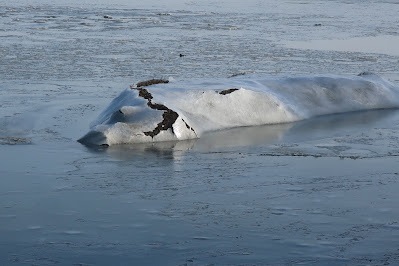We are in king tide season. King tides are the higher high tides of the year and winter is when the tides are the highest. The moon is the bigger driver of tides, but the sun is critical in the seasonal variability of tides that result in the highest tides of the year.
The earth is closest to the sun on about January 3 and hence the pull of the sun on the earth tides is greatest on that day. However, the tilt of the earth relative to the earth's orbit results in the Washington coast dipping downward into the maximum tide zone during the winter solstice. Hence, our highest astronomical tides take place in the December/January period.
Declination and tides from Hicks (2006).
In the above figure Washington State is approximately at the C-D line. The result is that when we are at position C we are in the king tide zone.
Other Factors
Storm Surge: The astronomical tide is impacted by meteorological forcing. A deep low pressure system will result in a higher tide level than the astronomical tide. The wind around the deep low pressure also results in water being piled up against the coast depending on the track of the low pressure. The track of a hurricane center is a very important component of the storm surge associated with hurricanes. The low pressure of the hurricane will result in storm surge but so does the wind. Being on the right hand side of an approaching hurricane (from the hurricane's view) can result in huge storm surges.
The same issue holds true for the Washington State coast. Deep low pressure systems bring lots of wind that will push and pile water up at different locations depending on the track of the low and the wind fields around the low. The impact of deep low pressure storms and associated wind fields on the inland waters of the Salish Sea is complex due to the shape of the multiple waterways. Yang and others (2019) modeled storm surge in the Salish Sea and provide an estimated maximum storm surge map for the Salish Sea.
Figure 12 from Yang and others (2019)
A large storm surge December 27, 2022 resulted in significant shoreline flooding as the storm surge coincided with an already high astronomical high tide event.
Water overtopping shoreline dike at Alice Bay, Skagit County
(note center road stripe under water)
Water overtopping shoreline dike at Alice Bay
(note white fog line road stripe under water)
18.61-year lunar nodal cycle: The plane of the orbit of the moon is inclined 5.145° from the equator. The result is that the moon's pull on the tide varies. When the moon is above the equatorial plane the pull is larger. We are currently in a period when the moon is more frequently above the equatorial plane during the king tide period. The result is more frequent tides being extra high this year as well as next and therefore the odds of a very high astronomical tide coinciding with a storm surge are greater this year and next than on average.
Timing of winter high tides
The tides set the waters of the ocean basins into motion. This moving water pushes up or pulls away continents and up into the inlets like such as the Salish Sea. The actual response of the ocean
basins and estuaries to tides is complicated and can lead to some pretty remarkable tides. I recall walking out on a dock in the Bay of Fundy with a 2 year old and being terrified of the potential fall hazard with boats 50 feet below us during low tide. Hicks (2006) provides a good overview of the factors that impact estuary tide levels.
A peculiar feature of tide interactions in the Salish Sea area I work along most frequently is the lack of low tide during the day light hours of winter. Assessments of shoreline bluffs in mid winter can be complicated by the tides as the plot below shows.
High tide was at about 8 in the morning, but the low tide at noon is not exactly low with second high tide coming in at 3:15 in the afternoon. The main low tide was really low - a negative tide at around midnight. Clam digging or oyster harvest at night in the winter.
I had a bit of hike to reach the shoreline bluff I needed to visit as there was no access down the very steep and high bluff for a few miles in both directions. I know this shore reach well enough that I figured I could make the 8 mile round trip hike with only the need for limited wading where the beach was narrow. With sunset at 4 the best I was going to get was a tide of about 8 feet. Note that there was minimal storm surge and the other plus was it was a calm day with no ocean swell coming in the strait. I started the hike after noon. The deepest wade was only shin deep and the waves were minimal. The water was warmer than the steady rain as the air temperature was 38 degrees.
House lights atop a high bluff above the Salish Sea
I took the above picture while heading back from my venture. I had to hold the camera against a log due to the darkness. The warm glow of the house lights struck me as a nice touch. I still had two miles to go to reach my car.
While I think most folks would consider that venture just awful, I was completely content. I had reached my destination, figured out the landslide complex and shoreline processes adequately, gotten a good hike in and timed the trip so it could be done. The satisfaction of field work!
























































